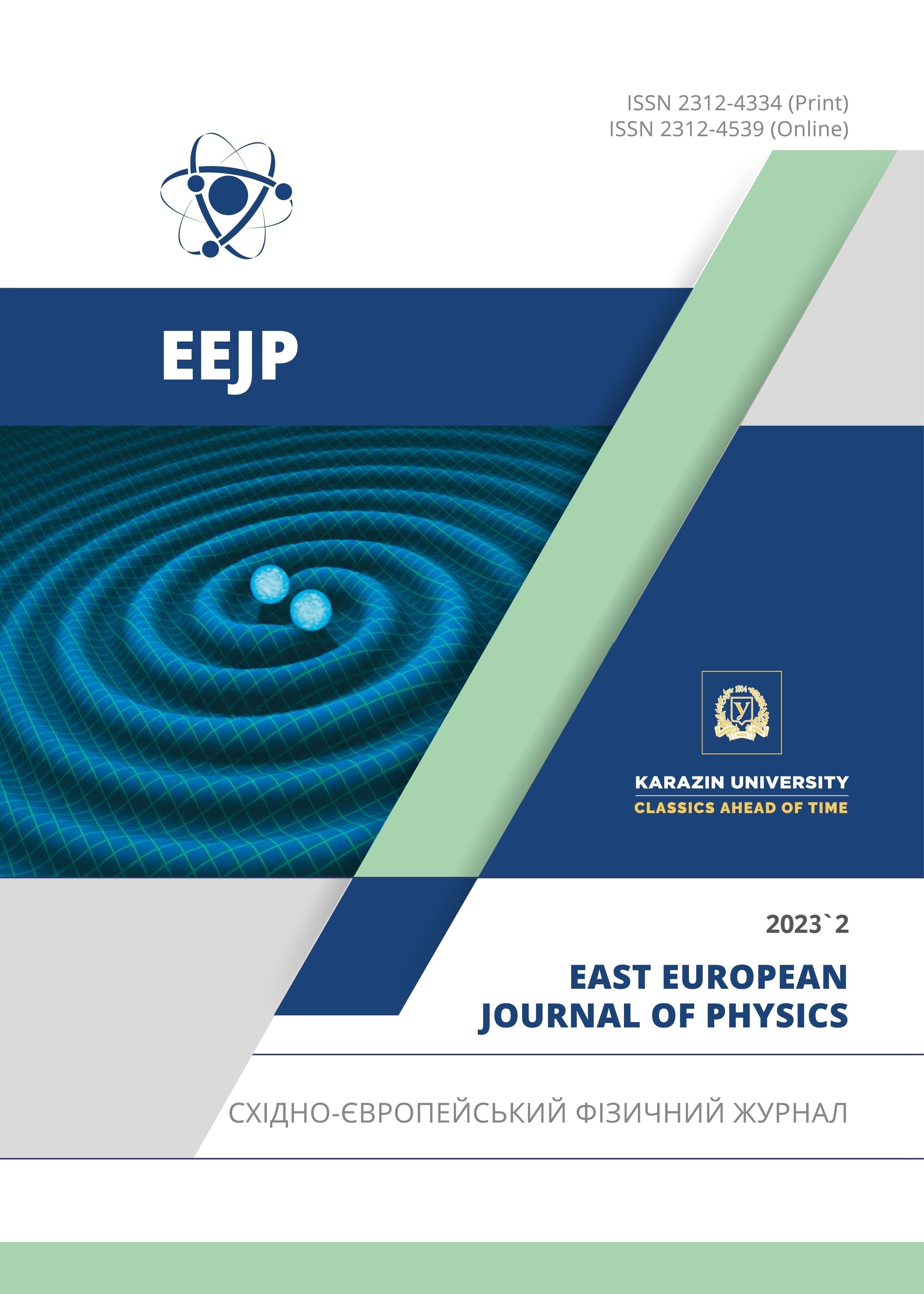Modeling the Distribution of Radionuclides in the Air and on the Soil Surface
Abstract
Mathematical and numerical methods are used to simulate physical and chemical processes when building models of pollutants dispersion in the air and on the soil surface. Based on meteorological data and information on the source of emissions, these models characterize both the primary pollutants entering the atmosphere directly and the secondary ones formed as the result of complex chemical reactions. These models are important for the air quality management system, as they allow monitoring emissions into the atmosphere, predicting their distribution, as well as developing effective strategies intended for reducing harmful substances in the atmosphere. The article presents an overview of computational methods used to simulate the pollutants dispersion in atmospheric air and on the soil surface, such as the Gaussian torch model, the Lagrangian dispersion stochastic model, and the Eulerian model of atmospheric diffusion. The practical application of the considered models showed sufficient reliability and validity of the air and soil pollution levels forecast. The simulation uses computer programs that include algorithms for solving the mathematical equations that control pollutant dispersion. The dispersion models are used to estimate the concentration of air pollutants or toxins. They can also be used to predict future concentrations under certain scenarios. They are useful for studying the pollutants that disperse over long distances and can initiate reactions in the atmosphere. Such software products are as follows: AEROPOL, AERMOD, GRAL, TAPM CSIRO, CALPUFF, HYSPLIT, etc. A method of processing information about the pollution sources and the environmental parameters, based on the HYSPLIT program, is proposed to form maps of the volume and surface activity of radionuclides. This method was applied to analyze the process of the plutonium isotopes dispersion as a result of the movement of air masses in the places of fires in April 2020 in the exclusion zone of the Chornobyl NPP, as well as the associated hazard for the population health and the environment.
Downloads
References
AirNow, U.S. Environmental Protection Agency, Office of Air Quality Planning and Standards (OAQPS), Information Transfer Group, Research Triangle Park, NC 27711, https://www.airnow.gov/international/us-embassies-and-consulates
S. Åström, L. Källmark, K. Yaramenka, and P. Grennfelt, Доклад C598-R. Меры по обеспечению качества воздуха в Европе и Центральной Азии [Report C598-R. Air quality measures in Europe and Central Asia], (IVL Swedish Environmental Research Institute, 2021), pp. 47. https://www.diva-portal.org/smash/get/diva2:1590828/FULLTEXT02 (in Russian)
V.M. Gulyaev, and L.V. Dranishnikov, Мониторинг окружающей среды [Environmental monitoring], (Publishing house DSTU, 2005), pp. 354. (in Russian)
M.E. Berlyand, Прогноз и регулирование загрязнения атмосферы [Forecast and regulation of atmospheric pollution], (Gidrometeoizdat, Leningrad, 1985), pp. 271. (in Russian)
I.I. Marchuk, Математическое моделирование в проблеме окружающей среды [Mathematical modeling in the problem of the environment], (Nauka, Moscow, 1982), pp. 320. (in Russian)
P.E. Benson, Caline4 – A dispersion model for predicting air pollutant concentrations near roadways, (Division of new technology and research, California, 1984), pp. 205.
W.B. Petersen, User's guide for HIWAY-2. A highway air pollution model. EPA600/8-80-018 (Research Triangle Park, N.C., U.S. EPA, 1980), pp. 83. https://nepis.epa.gov/
Finnish meteorological institute, Dynamicum, FI-00560 Helsinki, Atmospheric dispersion models at the Finnish Meteorological Institute, CAR-FMI, https://en.ilmatieteenlaitos.fi/air-quality-models
M. Kaasik, and V. Kimmel, International Journal of Environment and Pollution, 20(1-6), 114-120 (2004). http://dx.doi.org/10.1504/IJEP.2003.004256
Cambridge Environmental Research Consultants Ltd, Cardiff, Cambridge, CB2 1SJ, https://www.cerc.co.uk/environmental-software/ADMS-model.html
Aermod implementation guide, (U.S. Environmental Protection Agency, 2022), pp. 37. https://gaftp.epa.gov/Air/aqmg/SCRAM/models/preferred/aermod/aermod_implementation_guide.pdf
A. Melo, J. Santos, I. Mavroidis, and N. Reis Junior, Building and environment, 56, 8-20 (2012). https://doi.org/10.1016/J.BUILDENV.2012.02.017
M.E. Berlyand, Современные проблемы атмосферной диффузии и загрязнения атмосферы [Modern problems of atmospheric diffusion and atmospheric pollution], (Gidrometeoizdat, Leningrad, 1975), pp. 448. (in Russian)
GralDispersionModel, Graz University of Technology, Institute of Thermodynamics and Sustainable Propulsion Systems, Inffeldgasse 25C, 8010 Graz, Austria, https://github.com/GralDispersionModel/GRAMM
P. Hurley, CSIRO Marine and Atmospheric Research Paper No.25, (CSIRO, 2008), pp. 59. https://www.cmar.csiro.au/research/tapm/docs/tapm_v4_technical_paper_part1.pdf
SRC, CALPUFF Modeling System, http://www.src.com/.
National Oceanic and Atmospheric Administration, Air Resources Laboratory, NCWCP, R/ARL, Rm. 4204, 5830 University Research Court, College Park, Maryland 2074, HYSPLIT, ARL NOAA, https://www.arl.noaa.gov/hysplit/
R.R. Draxler, and G.D. Hess, Description of the HYSPLIT-4 Modeling System, (Silver Spring: Air resources Laboratory, NOAA Technical Memorandum ERL ARL-224, 1997), pp. 22. https://www.arl.noaa.gov/documents/reports/arl-224.pdf
R.R. Draxler, and G.D. Hess, Australian Meteorological Magazine, 47(4), 295-308 (1998).
Методика расчета концентраций в атмосферном воздухе вредных веществ, содержащихся в выбросах предприятий (ОНД-86) [Methodology for calculating the concentrations in the atmospheric air of harmful substances contained in the emissions of enterprises (OND-86)], (Leningrad: Gidrometeoizdat, 1987), pp. 94. (in Russian) http://www.sfund.kiev.ua/down/ond86.pdf
Методы расчетов рассеивания выбросов вредных (загрязняющих) веществ в атмосферном воздухе [Methods for calculating the dispersion of emissions of harmful (polluting) substances into the atmospheric air], http://www.consultant.ru/document/cons_doc_LAW_222765/0fdf0dd96d8d3a3c60e96b9afe38abfccd1cfe96/
УПРЗА "Эколог" вер. 4.x Программа расчета рассеивания [Unified Atmospheric Pollution Calculation Program "Ecologist" version 4.x Scattering program], https://forum.integral.ru/viewtopic.php?f=29&t=19176
УПРЗА «ЭКОцентр – Стандарт» [Unified Atmospheric Pollution Calculation Program "ECOcenter – Standard"], https://eco-c.ru/ecology/программы-для-экологов/упрза-экоцентр-стандарт/
M. Kozhevnikova, and V. Levenets, Radiation Science and Technology, 5(3), 20-26 (2019). http://dx.doi.org/10.11648/j.rst.20190503.11
M.F. Коzhevnikova, and V.V. Levenets, East Eur. J. Phys. 2, 161 (2021). https://doi.org/10.26565/2312-4334-2021-2-14
Copyright (c) 2022 Maryna F. Коzhevnikova, Volodymyr V. Levenets

This work is licensed under a Creative Commons Attribution 4.0 International License.
Authors who publish with this journal agree to the following terms:
- Authors retain copyright and grant the journal right of first publication with the work simultaneously licensed under a Creative Commons Attribution License that allows others to share the work with an acknowledgment of the work's authorship and initial publication in this journal.
- Authors are able to enter into separate, additional contractual arrangements for the non-exclusive distribution of the journal's published version of the work (e.g., post it to an institutional repository or publish it in a book), with an acknowledgment of its initial publication in this journal.
- Authors are permitted and encouraged to post their work online (e.g., in institutional repositories or on their website) prior to and during the submission process, as it can lead to productive exchanges, as well as earlier and greater citation of published work (See The Effect of Open Access).








